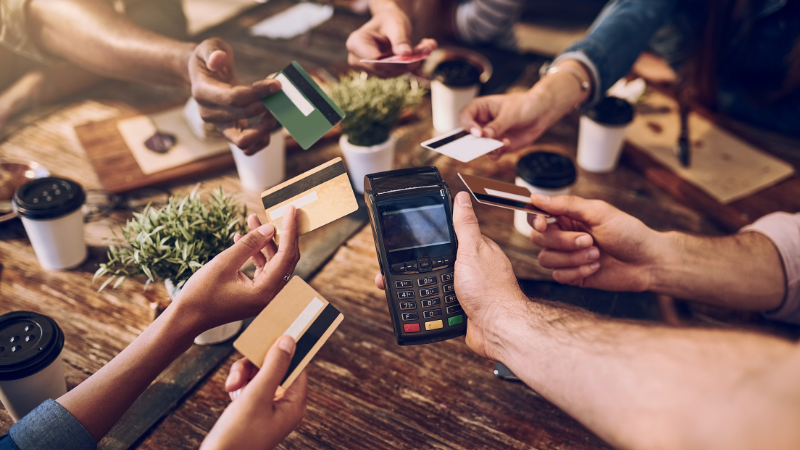
Digital Donations Save Time and Strengthen Your Non-profit’s Mission
Digital donations help Canadian non-profits raise more money, save time and earn donor trust through seamless, secure giving.

Once upon a time, a pocket full of coins and a stack of bills were all you needed to buy a coffee, catch a bus, or pick up groceries. Fast forward to 2025, and the story has changed: Canadians are tapping, waving, and scanning their way through checkout lines instead. Digital wallets and e-transfers have become the new norm, and cash, once the undisputed king of transactions, has been dethroned by an invisible force: contactless payments.
Back in 2016, Moneris predicted that cash would account for approximately 10 per cent of money spent by 2030. For small and medium-sized businesses trying to keep up, it’s crucial to understand how Canadians are paying today and what they expect from the brands they shop with.
Whether you’re a business owner, a tech-savvy shopper, or just curious about the future of money, the insights and tips shared here offer a clear picture of how businesses operate, how the pandemic nudged us all into a faster, more digital economy and what it takes to thrive in a cashless Canada.
In 2023, contactless transactions accounted for a staggering 63 per cent of all in-store payments in Canada, marking a 17 per cent increase from the previous year. This surge isn't just a fleeting trend; it's a reflection of a fundamental shift in consumer behaviour. Canadians are embracing the convenience and speed of tap-to-pay methods, leaving cash transactions in the rearview.
A Bank of Canada survey revealed that debit card ownership among Canadian adults reached 98 per cent, with credit card ownership also remaining robust. These statistics underscore a clear preference: Canadians favour card payments over cash. The ease of swiping or tapping a card, coupled with the widespread acceptance of digital payment methods, has made contactless payments a popular choice. But it’s not just in-store payments that are reshaping habits. The growth of e-commerce has also accelerated the decline of cash. Canadians expect the same seamless payment experience whether shopping online or at the counter, which means SMBs need to think about payments in an omni-channel way—ensuring consistency across both digital and physical storefronts.
For small and medium-sized businesses (SMBs), the impact is real. Relying only on cash or traditional payments can turn away customers. Businesses that don’t offer modern payment options may miss out on sales and repeat business. The State of Canadian Payments report highlighted that 47 per cent of business owners surveyed accepted mobile wallet payments, 41 per cent accepted contactless credit cards, and 33 per cent accepted peer-to-peer payments. These figures indicate that consumers expect a variety of payment options, and businesses that meet these expectations are more likely to thrive.
To keep pace with the evolving payment trends, SMBs should consider the following:
The rise of ecommerce has played a major role in accelerating the decline of cash and boosting contactless payments in Canada. According to Payments Canada, digital payments made up 86 per cent of total payment volume in 2023, while contactless transactions accounted for 53 per cent of all retail payments.
E-commerce also surged: Canadians completed 546 million online transactions worth $71.6 billion in 2023. That’s a 3 per cent year-over-year increase in both volume and value. As consumers spend more online, contactless and digital payments become natural ecosystems across both virtual and physical touchpoints pushing cash further into the background.
Digital wallets have become a key part of modern payments in Canada, offering a seamless and secure alternative to traditional methods. As of 2023, nearly half (47 per cent) of Canadians were actively using digital wallets, with another 25 per cent interested in adopting them. Things like digital wallets, and Interac e-Transfer allow users to store credit and debit cards, loyalty cards, tickets, and even identification, all within a single, secure platform.
This consolidation makes transactions faster and more convenient, reducing the need to carry physical cards or cash. Digital wallets also offer enhanced security features, such as tokenization, which protects users’ financial information. While widely used for everyday purchases, digital wallets also simplify entertainment spending, such as storing tickets for concerts, movies, or public transit digitally, making it easier than ever for Canadians to pay quickly and safely.
In Canada, major rideshare, and food delivery services have embraced a fully contactless payment model. For example, Uber no longer accepts cash. Riders must link a credit card, debit card, or another electronic payment method to their Uber account. This policy helps minimize disputes, reduce cash handling risks and theft, and streamline fare processing making rides safer and more efficient in cities like Vancouver and beyond.
Similarly, food delivery apps offer “contactless delivery” as a standard, and payment is completed entirely through the app using digital methods with no physical interaction or cash exchange required.
QR codes and e-transfers have become integral to Canada's digital payment ecosystem. These technologies facilitate quick and secure transactions, whether for splitting a bill among friends or paying for goods and services. Their widespread adoption reflects Canadians' growing comfort with digital payment methods and their desire for convenience.
QR code payments are gaining traction globally, with 44.6 per cent of internet users aged 16 to 64 scanning at least one QR code every month in 2023. In Canada, however, adoption has been limited because tap-to-pay options are already well established. That said, QR codes are gaining some traction in specific contexts, like menus, event check-ins, and certain retail experiences—so it’s worth watching how they evolve here.
The COVID-19 pandemic acted as a catalyst for the adoption of contactless payments in Canada. Concerns over hygiene and the desire for safer, quicker transactions led both consumers and businesses to embrace digital payment methods. Transit systems adopting contactless fare payments also accelerated this shift, giving Canadians another daily touchpoint to tap instead of carry cash.
Canadian transit systems are increasingly adopting contactless payment methods, allowing passengers to pay fares directly with debit and credit cards, as well as mobile wallets.
Toronto Transit Commission (TTC): As of August 15, 2023, the TTC has enabled passengers to tap their debit or credit cards directly at fare readers on all buses, streetcars, Wheel-Trans vehicles, and subway stations.
GO Transit: Passengers can tap on and off using credit or debit cards, including mobile wallets like Apple Pay and Google Pay, on all GO Transit trains and buses.
Beyond the GTA: Systems in Quebec, British Columbia, and even smaller regions like Belleville have also enabled direct debit and credit payments, making contactless travel possible in more parts of the country.
These payment upgrades make commuting easier and demonstrate to other sectors the benefits of going digital.
Yes, some Canadians feel overwhelmed by the shift toward digital payments, and those who are unbanked, underbanked, or living in rural areas may face additional barriers. Yet for many, going cashless has been a win. Contactless payments and digital wallets offer speed, security, and convenience that cash can’t match, making everyday purchases, entertainment, and access to public services smoother than ever.
For SMBs, staying competitive means keeping up with these changes: adopting modern payment solutions, exploring new technologies, and paying attention to emerging trends. Businesses that stay informed and adapt to Canadians’ evolving payment preferences are more likely to attract and retain customers in a fast-moving, digital-first economy.
____________________________________________________________________________
Sources:

Digital donations help Canadian non-profits raise more money, save time and earn donor trust through seamless, secure giving.

Explore Moneris’ 2025 year in review with insights on Canadian spending trends, sports-driven economic boosts, domestic tourism growth, holiday shopping behaviour and Quebec’s Bill 72 compliance.

Turn your gas station’s payment transactions into insights that improve staffing, inventory, promotions, and customer satisfaction.

In this guide, we’ll walk you through the types of content that work best for SMBs and give you blog topic ideas you can use today.